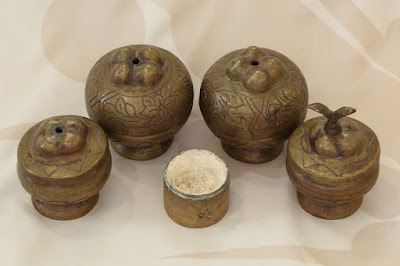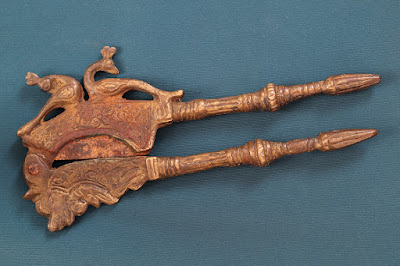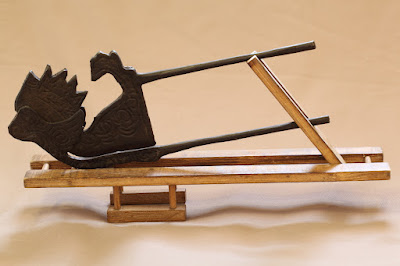Betel chewing is a habit that unites Southeast Asia with the Indian sub-continent, parts of Southern China and the Western Pacific. Whereas alcohol was associated with feasting, betel was the everyday social lubricant. It was offered to visitors to one’s home. And just as the English developed elaborate tea sets, Indians and Southeast Asians developed elaborate betel nut sets.
Betel took on symbolic meaning too and was a central element of traditional marriage
ceremonies. Among Malays, betel or tepak sirih (betel leaf container) would be sent to the parents of a prospective bride, and if they accepted it, then it meant that they consented to the marriage.
In general, tepak sirih contains seven uniquely selected items such as betel nut, lime (kapur), extract from the leaves of gambier plant (gambir), tobacco, betel leaves and betel nut cutter / nutcracker (kacip). All of the items except kacip are kept in six different smaller containers known as cembul.
The betel leaves are arranged in a group of five to seven pieces folded together. All ingredients are placed accordingly and are not done haphazardly. There are precise sections of the tepak sirih that hold the ingredients.
The actual nut comes from the areca palm tree. Typically, it is sliced, mixed with lime and then wrapped up in a betel creeper leaf and chewed. The lime reacts with compounds in the nut to produce alkaloids which give a mild narcotic effect. At the same time, large amounts of red saliva are also produced which the chewers will then spit it out.
Pictures below are the betel nut paraphernalia from my collection.
 Looking at the brass bowl, it can be separated from the betel tray set. Bowls such as these were used to hold betel sets, from which betel could be offered to visitors, and to hold food, such as fruits.
Looking at the brass bowl, it can be separated from the betel tray set. Bowls such as these were used to hold betel sets, from which betel could be offered to visitors, and to hold food, such as fruits.And pictures below are another two complete sets of Malay brass tepak sirih in my collection. These two are almost as similar as the tepak sirih in the first picture above, only the two tepak sirih below (same size) are slightly smaller in size than the one in the first picture.
 Betel nut cutter.
Betel nut cutter.This Balinese Hindu style betel nut cutter is in the shape of a winged horse. The handles are in silver and the body is made of iron.
 An iron kacip (Balinese) in the shape of a magnificent horse, with its mane and body, picked out in gold. The body bears a decorative inlaid pattern of swastikas, also picked out in gold. The handles are sheathed in gilded metal.
An iron kacip (Balinese) in the shape of a magnificent horse, with its mane and body, picked out in gold. The body bears a decorative inlaid pattern of swastikas, also picked out in gold. The handles are sheathed in gilded metal. An iron kacip from Central of Java, with silver inlay in the form of a stylized bird. The handles are sheathed in silver.
An iron kacip from Central of Java, with silver inlay in the form of a stylized bird. The handles are sheathed in silver. An iron kacip in the Thai style from North of Kelantan, but highly stylized to conform with Islamic teaching. It is with lotus flower motifs on the eyes and hinges. The handles are partly sheathed in brass, also ending in a lotus bud shape.
An iron kacip in the Thai style from North of Kelantan, but highly stylized to conform with Islamic teaching. It is with lotus flower motifs on the eyes and hinges. The handles are partly sheathed in brass, also ending in a lotus bud shape. An iron kacip (Balinese) in the shape of a stylized winged horse, with inlaid
An iron kacip (Balinese) in the shape of a stylized winged horse, with inlaidcopper circles in its mane. The handles are sheathed in silver and embossed with a scaly motif.
There are another few items which also categorized as the betel nut paraphernalia in my previous blog. They are the "Silver Betel / Tobacco Box", the "Spittoons", the "Asam Gelugor Fruit-Shaped Brass Container" and the "Indonesian Betel Or Tobacco Box". :)








































































I found a set....if I send you pictures, do you think you could give me info on it
ReplyDeleteWill definitely try my best..... :) Clear pictures does help a lot too....
DeleteGreetings from The Malay Peninsular. Dear sir, I would like to share a bit of my knowledge about the betel nut set which you`ve published. To my knowledge the first set and third were not originated from the Malays in the peninsular. They belongs to the Javanese which probably in the middle part of Java Island. I have to say these because there are a few differences in the shape and model between the Malays and Javanese betel nut set. These differences are obvious and were closely related to the custom and philosophy of their tradition. just a sharing from a piece of my mind.
ReplyDeleteBeautiful ❤️ from West Bengal...serving betal leaves and nut is the most important ritual in Hindu bengalis, we serve it to Puja, wedding... In past people used to invite eachother by giving betal leaves.
ReplyDelete